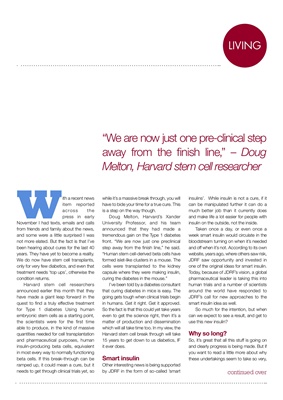
With a recent news
item reported
across the
press in early
November I had texts, emails and calls
from friends and family about the news,
and some were a little surprised I was
not more elated. But the fact is that I've
been hearing about cures for the last 40
years. They have yet to become a reality.
We do now have stem cell transplants,
only for very few diabetics, and even that
treatment needs 'top ups', otherwise the
condition returns.
Harvard stem cell researchers
announced earlier this month that they
have made a giant leap forward in the
quest to find a truly effective treatment
for Type 1 diabetes Using human
embryonic stem cells as a starting point,
the scientists were for the first time
able to produce, in the kind of massive
quantities needed for cell transplantation
and pharmaceutical purposes, human
insulin-producing beta cells, equivalent
in most every way to normally functioning
beta cells. If this break-through can be
ramped up, it could mean a cure, but it
needs to get through clinical trials yet, so continued over
while it's a massive break through, you will
have to bide your time for a true cure. This
is a step on the way though.
Doug Melton, Harvard's Xander
University Professor, and his team
announced that they had made a
tremendous gain on the Type 1 diabetes
front. "We are now just one preclinical
step away from the finish line," he said.
"Human stem cell-derived beta cells have
formed islet-like clusters in a mouse. The
cells were transplanted to the kidney
capsule where they were making insulin,
curing the diabetes in the mouse."
I've been told by a diabetes consultant
that curing diabetes in mice is easy. The
going gets tough when clinical trials begin
in humans. Get it right. Get it approved.
So the fact is that this could yet take years
even to get the science right, then it's a
matter of production and dissemination
which will all take time too. In my view, the
Harvard stem cell break through will take
15 years to get down to us diabetics, IF
it ever does.
Smart insulin
Other interesting news is being supported
by JDRF in the form of so-called 'smart
insulins'. While insulin is not a cure, if it
can be manipulated further it can do a
much better job than it currently does
and make life a lot easier for people with
insulin on the outside, not the inside.
Taken once a day, or even once a
week smart insulin would circulate in the
bloodstream turning on when it's needed
and off when it's not. According to its own
website, years ago, where others saw risk,
JDRF saw opportunity and invested in
one of the original ideas for smart insulin.
Today, because of JDRF's vision, a global
pharmaceutical leader is taking this into
human trials and a number of scientists
around the world have responded to
JDRF's call for new approaches to the
smart insulin idea as well.
So much for the intention, but when
can we expect to see a result, and get to
use this new insulin?
Why so long?
So, it's great that all this stuff is going on
and clearly progress is being made. But if
you want to read a little more about why
these undertakings seem to take so very,
LIVING
"We are now just one preclinical step
away from the finish line," -- Doug
Melton, Harvard stem cell researcher